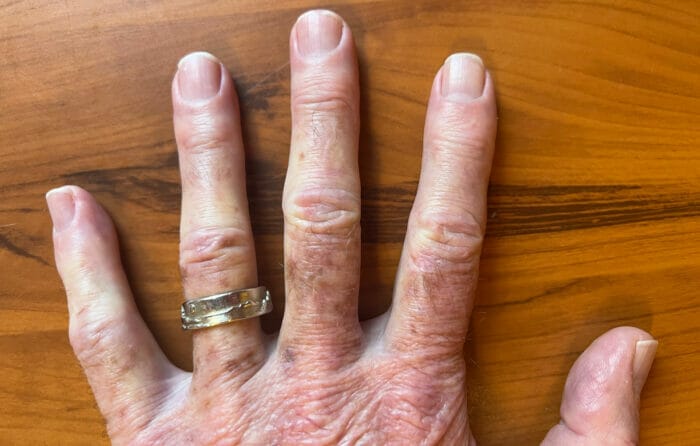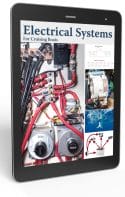
One more chapter before we get to the good stuff, this one on safety. I know, even more boring than the two theory chapters you just endured. Still, it’s a short one, so please don’t skip it. I would hate see anyone get hurt.
Just because the battery-supplied systems on cruising boats are low voltage, that does not make them safe, and yet that’s the common view.
Sure, none of the DC voltages on our boats (12, 24 or 48) will hurt us—except possibly the last, and then only in special circumstances (don’t stick a 48-volt wire in your mouth)—but the current (amperage) sure can¹.
So let’s take a look at five ways we can reduce the chances of getting hurt. Particularly relevant since in the first chapter we encouraging you to work on your own system².
¹Actually, it’s always the current that damages people, even in high voltage (shore power) systems, but let’s not split the hair in four.
²If this sounds like an article written to cover my ass and keep our journalism insurance underwriters happy, trust your instincts. Nonetheless, these tips reduce, but do not eliminate, very real risks.


Hi John,
Great reminders.
When working on the batteries with a wrench long enough to bridge the gap between terminals, I tape the non-working end of the wrench. I have been tempted, on occasion, to buy a shorty wrench set (or a few dedicated shorty wrenches) for just this reason also. One rarely needs the extra length for its ability to provide torque.
My best, Dick Stevenson, s/v Alchemy
Buy yourself a couple of electrically insulated spanners. They are a MAHOOSIVE piece of mind when doing that! And not very expensive, you just need one or two. And the same goes for screwdrivers. I have a set of the most common ones that are fully insulated except for the tip. Here’s a selection from Tengtools (just random brand) as an example https://www.tengtools.com/no/products/insulated-tools
Hi Arne,
I agree, that’s the best solution.
Hi Dick,
Good tip on the tape. Rather than buying a short wrench, I think I would just use one with an insulated handle. https://www.grainger.ca/en/product/p/CRSAT2610CVS
I got a Knipex “toothless” channel lock wrench a couple of years ago and the handles are insulated. I seem to find a use for it every day as it doesn’t mar metals but isnlarge enough to provide reasonable leverage.
Hi John,
I wired my inverter to include an on/off switch in the positive lead from the battery bank: this not only limits the territory for DC to roam, but precludes the chance that a more dangerous AC connection might be discovered lurking in that maze of wiring.
My best, Dick Stevenson, s/v Alchemy
Good point, Dick. It’s been on my list since being suggested by my electrical guru, an advisor on the ABYC electrical standards group. I’d better hop to it!
Hi Dick,
Good idea. The other option is to just pull the fuse to the inverter, which should be there anyway, and reduces the number of contacts.
After learning this is SOP on, I think, Jeanneaus, I put a positive side on/off switch in also. I use it not just for typical jobs, but when I service the bank periodically.
Hi John and all,
At the beginning of the season, I had occasion to reach deep in to an area not visited in many a year and came out with an impressive slice on the back of my wrist from a cut-off (but still protruding) electrical tie.
I am forever impressed with how I go through electrical ties when doing wiring (and for securing in other projects as well) and one of my favorite tools, always ready-at-hand when working with electrical ties, is a pair of flush cutting diagonal cutters (Xcelite 170M). With a snip the tie is flush cut leaving no sharp ends to catch you (or a later workers) unawares.
My best, Dick Stevenson, s/v Alchemy
Hi Dick,
Good point! This is indeed an “electrical” work safety issue. I’ve spilled significant amounts of red stuff after cutting myself on these sharp ends. They can be as small knifes. Protruding screws are on the same team of mostly non lethal, but abundant danger zones where electric wires live.
Hi Dick,
I have always just cut them off with standard wire cutters and can’t say I have ever sliced myself—maybe I’m thick skinned in more ways than one!
That said, I finally bought a dedicated wire tie cut off tool, and I do agree it does a nice job. The advantage of the the one I bought from Macmaster Carr is that it tensions the tie too. Not vital but nice to have:https://www.mcmaster.com/cable-tie-tools/
A larger size stainless toenail-clipper, the type with the black plastic “catcher” at the sides to retain the little plastic cutoffs works well. Simply cut off the tie close to the end with the clippers held on an angle or using pliers for larger ties.
Then clip the sharp end remaining with your nail clipper as you would a finger nail. Puts a perfect radius on the corners.
Very much looking forward to your in depth article on rewiring your J109.
Hi Ian,
Thanks for the interest. Working on it at the moment. Doing it right with diagrams and BOM is big project!
Wedding rings are dangerous in lots of situations on sail boats. When I started cruising full time I swapped mine out for a silicone ring. They come in lots of different styles.
Hi Gino,
That’s a good idea, I had never heard of such a thing.
Years ago while doing safety training in the navy, they showed us LOTS of pictures of “degloved” fingers to get the point across. To this day, I only wear my wedding ring on special occasions, like my anniversary.
Hi Steven,
Yikes, the descriptions from my surgeon friend were scary enough.
My maternal grandfather had a nasty scar from a high amperage short across his wedding ring. They cut it off and he never wore one again. The scar was still bad 50 years later.
My first boss had 9 fingers, the result of a de-gloving injury climbing down a ladder (it caught it on the grip tread as he jumped down the last rung).
I had two minor catches (both on threads exposed past nuts) with mine the first month after I was married. That was the end of that.
Hi Drew,
Sobering indeed. I still wear a wedding ring, but am pretty good about taking it off before I go near tools or the boat. That said, your solution is even better, I think.
Thanks guys. I’m replacing my keel-lift winch this weekend. I’ll disconnect the battery and tape over at least one terminal while we work on it. My sons will be helping with the project so you can tell your insurer that the safety lesson will cross two generations.
Cheers
Hi PD,
Thanks, our journalism insurance underwriters will, I’m sure, go back to their castle very happy!